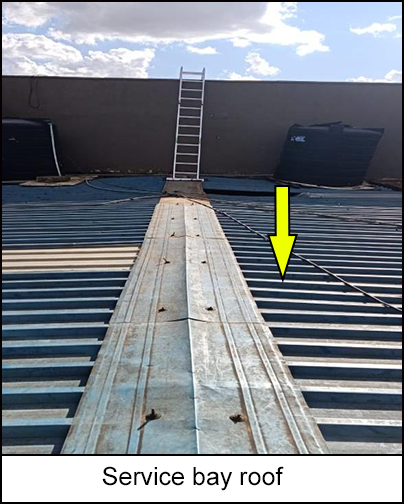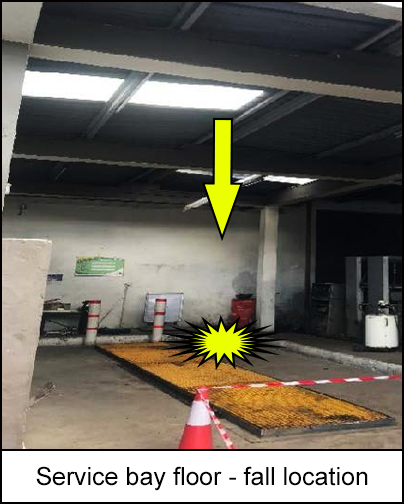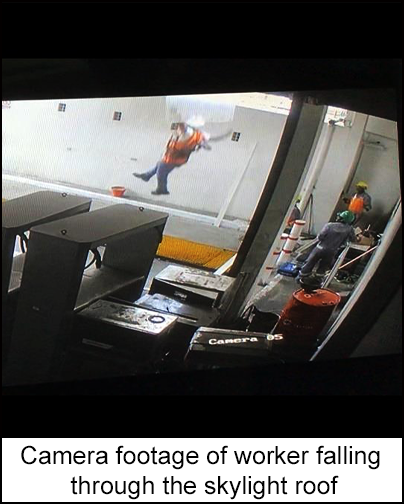-
What happened?
A worker was inspecting the solar panels installed on a service station rooftop.
He was walking on the service bay roof to access the solar panel worksite.
He stepped away from the purlin walkway onto the roof sheets to take some photos. He then turned and stepped on the skylight roof sheet, which gave in.
He fell 4.5m/16ft to the service bay floor.
There were no immediate physical or visible injuries but he was admitted to the hospital for further observation.

-
Why did it happen?
Lack of a designated and restricted walkway on top of the service bay roof.
The worker was wearing an unsecured safety harness.
Insufficient protective equipment on the service bay roof. Lack of safety lifeline or anchor points for safety harness on the roof walkway.
Presence of skylight sheet on the service bay roof. Workers were not aware of the risks of walking on skylight sheets.
Incomplete risk analysis: risks related to access to the worksite through the service bay roof not documented.
Lack of safety induction on specific site risks for visitors and inspectors.

-
What did they learn?
If there is a safer way to do the job, avoid working at height where possible.
A comprehensive risk assessment is required when working at height:
- Identify and document all the hazards.
- Put in place suitable protection, e.g. safety lifeline, secured harnesses, designated walkways, anchor points, etc.
Plan the work carefully. Do not deviate from the plan without authorisation.
Make sure everyone understands the risks.

-
Ask yourself or your crew
How can something like this happen here?
What else can we learn from this incident?
How do we know we have assessed all risks and hazards of today’s working at height job?
Do we need to work at height today? Is there a safer way to do the job?
What fall protection do we have in place? What more can we do to make this job safer?
What is the plan for today’s work? What issues might we encounter that we haven’t thought of?

Add to homescreen
Content name
Select existing category:
Content name
New collection
Edit collection
What happened?
A worker was inspecting the solar panels installed on a service station rooftop.
He was walking on the service bay roof to access the solar panel worksite.
He stepped away from the purlin walkway onto the roof sheets to take some photos. He then turned and stepped on the skylight roof sheet, which gave in.
He fell 4.5m/16ft to the service bay floor.
There were no immediate physical or visible injuries but he was admitted to the hospital for further observation.

Why did it happen?
Lack of a designated and restricted walkway on top of the service bay roof.
The worker was wearing an unsecured safety harness.
Insufficient protective equipment on the service bay roof. Lack of safety lifeline or anchor points for safety harness on the roof walkway.
Presence of skylight sheet on the service bay roof. Workers were not aware of the risks of walking on skylight sheets.
Incomplete risk analysis: risks related to access to the worksite through the service bay roof not documented.
Lack of safety induction on specific site risks for visitors and inspectors.

What did they learn?
If there is a safer way to do the job, avoid working at height where possible.
A comprehensive risk assessment is required when working at height:
- Identify and document all the hazards.
- Put in place suitable protection, e.g. safety lifeline, secured harnesses, designated walkways, anchor points, etc.
Plan the work carefully. Do not deviate from the plan without authorisation.
Make sure everyone understands the risks.

Ask yourself or your crew
How can something like this happen here?
What else can we learn from this incident?
How do we know we have assessed all risks and hazards of today’s working at height job?
Do we need to work at height today? Is there a safer way to do the job?
What fall protection do we have in place? What more can we do to make this job safer?
What is the plan for today’s work? What issues might we encounter that we haven’t thought of?
A worker used a service bay roof to gain access to a worksite. He fell through a skylight sheet 4.5 meters/16 feet to the service bay floor. Access using the roof had not been documented. No fall protection was in place.












